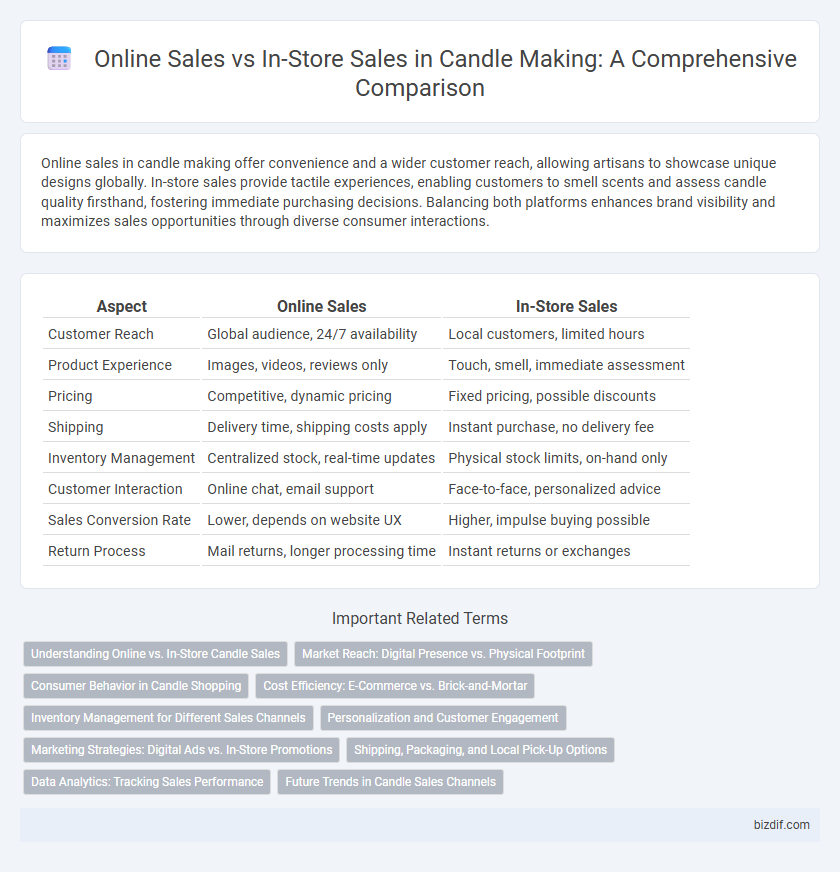Online sales in candle making offer convenience and a wider customer reach, allowing artisans to showcase unique designs globally. In-store sales provide tactile experiences, enabling customers to smell scents and assess candle quality firsthand, fostering immediate purchasing decisions. Balancing both platforms enhances brand visibility and maximizes sales opportunities through diverse consumer interactions.
Table of Comparison
| Aspect | Online Sales | In-Store Sales |
|---|---|---|
| Customer Reach | Global audience, 24/7 availability | Local customers, limited hours |
| Product Experience | Images, videos, reviews only | Touch, smell, immediate assessment |
| Pricing | Competitive, dynamic pricing | Fixed pricing, possible discounts |
| Shipping | Delivery time, shipping costs apply | Instant purchase, no delivery fee |
| Inventory Management | Centralized stock, real-time updates | Physical stock limits, on-hand only |
| Customer Interaction | Online chat, email support | Face-to-face, personalized advice |
| Sales Conversion Rate | Lower, depends on website UX | Higher, impulse buying possible |
| Return Process | Mail returns, longer processing time | Instant returns or exchanges |
Understanding Online vs. In-Store Candle Sales
Online candle sales provide access to a broader market with detailed product descriptions, customer reviews, and the convenience of home delivery, driving higher volume through e-commerce platforms. In-store sales offer tactile experiences that allow customers to smell scents and examine candle quality firsthand, fostering immediate purchase decisions and brand loyalty. Understanding the balance between the expansive reach of online sales and the sensory engagement of physical stores helps candle makers optimize sales strategies and inventory management.
Market Reach: Digital Presence vs. Physical Footprint
Online sales offer candle makers a broader market reach by leveraging digital platforms, social media, and e-commerce websites to attract a global audience 24/7. In contrast, in-store sales rely on a physical footprint that limits customer access to local or regional buyers but provides tactile experiences and immediate purchase gratification. The digital presence enhances brand visibility and customer engagement, while physical stores benefit from personalized service and direct product interaction.
Consumer Behavior in Candle Shopping
Consumers increasingly prefer online candle shopping due to the convenience of browsing diverse scents, styles, and customizations from home, driving higher digital sales. In-store experiences still attract buyers seeking tactile interaction with candle textures, colors, and immediate product availability. Consumer behavior reflects a blend of impulsive purchases in-store and deliberate, research-driven decisions online, highlighting the importance of multichannel retail strategies in candle making.
Cost Efficiency: E-Commerce vs. Brick-and-Mortar
Online candle sales reduce overhead costs by eliminating the need for physical retail space, resulting in lower expenses for rent, utilities, and in-store staff. E-commerce platforms enable direct-to-consumer pricing strategies that improve profit margins through reduced intermediary fees. Conversely, brick-and-mortar stores incur higher operational costs but benefit from immediate customer interaction and impulse purchases that can drive sales volume.
Inventory Management for Different Sales Channels
Inventory management in candle making requires distinct strategies for online sales versus in-store sales, with online channels demanding real-time stock updates and efficient order fulfillment systems to accommodate higher volume and broader geographic reach. In-store sales benefit from visual merchandising and immediate availability, necessitating accurate stock levels and replenishment schedules to enhance customer experience and prevent overstocking. Integrating inventory management software that synchronizes both channels minimizes discrepancies, optimizes stock turnover, and supports data-driven decision-making for production planning.
Personalization and Customer Engagement
Online sales platforms offer extensive personalization options for candle products, enabling customers to customize scents, labels, and packaging, which enhances user engagement through tailored experiences. In-store sales provide direct interaction with products, allowing customers to test fragrances and receive immediate feedback, fostering a personal connection and trust with the brand. Leveraging both channels optimizes customer engagement by combining tactile exploration with customizable convenience, leading to increased satisfaction and loyalty in the candle market.
Marketing Strategies: Digital Ads vs. In-Store Promotions
Effective candle marketing strategies differ significantly between online sales and in-store sales, with digital ads driving targeted traffic through social media platforms and search engine marketing, enabling precise audience segmentation and performance tracking. In-store promotions rely on sensory engagement, such as fragrance sampling and attractive displays, to encourage immediate purchases and enhance customer experience. Leveraging data analytics in digital campaigns allows candle makers to optimize ad spend and tailor messaging, while tactile elements in physical stores build brand loyalty and foster repeat visits.
Shipping, Packaging, and Local Pick-Up Options
Online sales of candles require careful shipping and packaging to prevent damage and preserve scent quality during transit, often involving eco-friendly materials to appeal to conscious consumers. In-store sales allow customers to inspect products firsthand and avoid shipping delays, with the advantage of immediate local pick-up, enhancing convenience and reducing carbon footprint. Offering flexible options like curbside pick-up or local delivery bridges the gap between online and in-store experiences, boosting customer satisfaction and sales potential.
Data Analytics: Tracking Sales Performance
Data analytics plays a crucial role in tracking sales performance for both online and in-store candle sales by providing detailed insights into customer preferences, purchasing patterns, and peak sales periods. Online sales platforms offer real-time data dashboards that enable candle makers to analyze conversion rates, average order values, and customer demographics more precisely than traditional in-store methods. Integrating point-of-sale systems with analytics tools in physical stores facilitates efficient stock management and identifies trends, helping candle businesses optimize marketing strategies and inventory control.
Future Trends in Candle Sales Channels
Online candle sales are projected to outpace in-store purchases due to increasing consumer preference for convenience and wider product variety available digitally. Enhanced e-commerce platforms with virtual scent experiences and personalized recommendations are driving higher engagement and sales growth. In-store candle sales will focus on experiential marketing and tactile product interaction to complement the digital shift in future retail trends.
Online sales vs In-store sales Infographic

 bizdif.com
bizdif.com